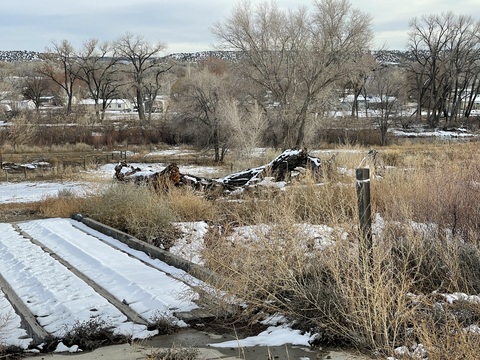
For more than 40 years, I lived on land north of Aztec, NM that I shared with a tall, weather scarred cottonwood tree. Many different bird species perched in it, and a goose once laid its eggs in a cleft between two of its huge branches.
At one time, the Healing Tree seemed to be a good name for the cottonwood. There was a peacefulness about it that made people feel less stressed. In 2015, I called a young adult fantasy novel I wrote The Healing Tree. The cover bears a picture of the tall cottonwood. An artist outlined the tree with mystical looking lines to emphasize the book's fantasy focus.
Later, Grandfather Tree seemed like a better name for the tree. It had weathered many storms and survived probably more than two hundred years.
When I lived on that land, I often spent time near Grandfather Tree as I walked up and down the irrigation ditch bank. The tree sent deep roots into the soil next to a wooden bridge that crossed the ditch. I moved away almost six years ago but never forgot the cottonwood. Sometimes I would pray for it, asking that it have whatever it needed to stay healthy.
In early spring last year, I couldn't stop thinking about Grandfather Tree. It made me wonder if the tree was okay. I made a special 12-mile trip from my new home in Farmington, NM so I could drive past the tree. Its branches spread tall and wide like they had for many years. I prayed for the tree again and headed back to my new home, relieved to see that it was doing well.
This Monday, Grandfather Tree came into my mind so strongly that I couldn't stop thinking about it. On my way home from nearby Durango, Colorado, the tree continued to stay on my mind. Instead of driving on the highway on the east side of the Animas River, I drove down a county road on the west side of the river. It took me past where I used to live.
My heart sank when I saw the tree. It lay in pieces on the irrigation ditch bank. I felt devastated, as though I had lost a dear friend. What had caused the tree to fall?
I stopped at the home of former neighbors who lived two houses down from my old house. They filled me in on the details. Convinced that the old cottonwood was hollow inside and no longer safe, the irrigation ditch rider knocked the tree down last spring. I felt close to tears.
I drove back to the bridge that crossed the irrigation ditch on the property I once owned and parked at the edge of the road. Taking out my cell phone, I walked toward the wooden bridge to take pictures of the once majestic tree.
The bridge was covered with snow that could be slippery, and the neighbor had warned me that a mean dog owned by neighbors roamed free and bit people. I decided to stay close to my car, so I didn't cross the bridge to see for myself if the tree was really hollow.
I kept wondering why the tree didn't come into my mind when it was being knocked down last year. Yet, on this day, many months later, the tree wouldn't leave my thoughts. Why now? I may never know.
As I drove home, praying for the tree, I felt as though its trunk fit gently around my body, giving me a comforting hug. In my mind, the tree remains alive in spirit, and the attachment that grew between us for so many years is also very much alive.





